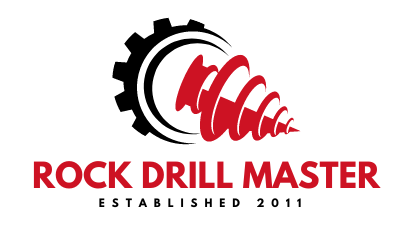In the world of rock drilling, two primary methods dominate: Down-The-Hole (DTH) drilling and Top Hammer drilling. Each technique has its own strengths and weaknesses, making it suitable for certain situations and less ideal for others. If you’re planning a drilling project, understanding the differences between DTH and top hammer drilling is crucial for choosing the right approach. In this article, we’ll compare how they work and weigh their pros and cons in terms of drilling performance, hole size, depth, precision, and cost.
(Rock Drilling Photos, Download The BEST Free Rock Drilling Stock Photos & HD Images) A driller using a pneumatic top-hammer drill (jackleg) on a rock face. In top hammer drilling, the impact hammer is at the drill head (external to the hole), sending shock waves through the drill rod to the bit.
How They Work: Key Differences
- Top Hammer Drilling: In top hammer (also called percussion or drifter drilling), the hammering action is generated at the top of the drill string, usually by a drifter or rock drill on the rig. This impact energy travels down the drill steel (rod) to the bit at the bottom. The bit (often a threaded button bit) strikes the rock and rotates slightly with each blow, chipping away rock. Flushing medium (air or water) flows down separate channels to clear cuttings. Top hammer is commonly seen in hand-held rock drills, drill jumbos in underground mines, and surface drill rigs for smaller holes. Because the impact wave attenuates with rod length, efficient top hammer drilling is typically limited to shallower holes (several tens of meters deep at most) (Sandvik introduces Top Hammer XL, a fully optimized top hammer system …) ([EVERDIGM AMERICA INC] T500).
- Down-The-Hole (DTH) Drilling: In DTH drilling, the hammering mechanism is at the bottom of the hole, directly behind the drill bit. A pneumatic (or sometimes hydraulic) DTH hammer strikes the bit internally, and the entire assembly gradually moves downward as drilling progresses. The percussive energy doesn’t need to travel through long rods – it’s delivered right to the bit – so it doesn’t lose intensity with depth. DTH drills use threaded drill pipes to push and rotate the hammer + bit, with compressed air delivered down the pipe to power the hammer and flush cuttings up the hole (Down-the-hole drill – Wikipedia) (Down-the-hole drill – Wikipedia). DTH is usually for larger diameter holes or deeper holes (e.g., 90mm up to 1000mm diameter, depths of hundreds of meters in some cases).
In summary: Top hammer = hammer blows from the top, travels through rod; DTH = hammer blows at the bottom, directly on bit. Now, let’s compare their advantages and disadvantages.
Drilling Performance Comparison
- Hole Depth Capability
- Top Hammer: Generally efficient up to around 20–30 meters in hard rock for small to medium diameter holes (say < 4 inches). Can go deeper (50m or slightly more) in ideal conditions or with very heavy rigs, but penetration rate and accuracy degrade because energy diminishes and rods can start bending or deviating.
- DTH: Excels at greater depths. DTH can maintain good penetration even at 100m, 200m, or more (particularly for hole diameters 4–12 inches). There’s practically no depth limit from an energy transmission standpoint – depth is usually limited by rod handling and flushing.
- Hole Diameter Range
- Top Hammer: Commonly used for smaller diameters like 2 to 5 inches (51 to 127 mm) in surface drilling, and even smaller (27–45 mm) in tunneling or bolting. Larger diameter top-hammer drilling (e.g., 6–8 inches) becomes challenging because the percussive energy spreads out, and very large bits put tremendous strain on the drilling rods and threads.
- DTH: Ideally used for medium to large diameter holes. Typically 3 inches up to 24+ inches. For very large holes (say 18 inches and above), DTH is often the only feasible method short of specialized raise boring or rotary drilling, because you can use multiple DTH hammers or custom big hammers. Modern “Top Hammer XL” systems (by Sandvik, etc.) are pushing top-hammer into the 6–7 inch range with new technology (Sandvik introduces Top Hammer XL, a fully optimized top hammer system …), but traditionally those were firmly DTH territory.
- Penetration Rate
- In hard rock (shallower holes): Top hammer drills can be extremely fast. The blows per minute in top hammer drills are very high (some drifters hit >2500 blows/min) and the mechanical rotation is fast, so for shallow production drilling (like bench drilling under 20m), top hammer often drills quicker on a per-meter basis.
- In deep holes or very hard dense rock: DTH tends to catch up or exceed top hammer, because top hammer loses energy and requires more retraction and re-drilling to clear cuttings at depth.
- In soft or fractured rock: Both systems might be limited by how fast cuttings can be cleared or the need to slow down to maintain hole integrity. DTH’s steady impact might actually produce less damage to fragile formations around the hole, as top hammer’s shock through the rod can cause more vibration.
- Hole Straightness and Accuracy
- Top Hammer: More prone to hole deviation, especially as depth increases. The drill string can flex, and any minor bedding planes or hard spots can nudge a top-hammer bit off course. Also, each rod connection is a potential slight misalignment. For small short holes (like 2m rock bolt holes), this isn’t an issue; but for 30m holes, deviation could be significant (the hole may drift several percent off line).
- DTH: Renowned for excellent hole straightness. The weight and rigidity of the hammer directly behind the bit acts as a stabilizer. Also, DTH bits often have guiding features and don’t wander easily. It’s possible to achieve very straight long holes (deviation maybe <1% or so in many cases). That’s why DTH is preferred for services like pre-split blasting, monitoring wells, or foundation piles where alignment matters.
Let’s put these points in an easier side-by-side view:
Table: DTH vs. Top Hammer – Quick Pros & Cons
| Aspect | Down-The-Hole (DTH) | Top Hammer |
| Effective Depth | ✅ Excels at deep holes (tens to hundreds of meters) with minimal energy loss. | ⚠️ Best for shallow to moderate depth; performance drops off with depth. |
| Hole Diameter | ✅ Ideal for medium to large diameters (75mm to 1000mm+). Very large holes possible. | ⚠️ Typically used for smaller holes (25mm to ~127mm). Large holes put stress on rods. |
| Penetration Rate | ✅ Consistent rate even as hole gets deeper; great in hard rock at depth. ⚠️ Slower to start in shallow hard rock vs top hammer, due to lower strike rate. | ✅ Very fast in hard rock for short holes (high impact frequency). ⚠️ Slows down at depth as energy dampens; more drilling interruptions (adding rods). |
| Hole Straightness | ✅ Very straight holes due to hammer alignment and rigidity. Preferred for precision drilling. | ⚠️ More deviation likely, especially over long holes; rods can flex and stray in heterogeneous ground. |
| Vibration & Noise | ✅ Lower vibration transferred to rig/operators (hammer impacts are downhole). Generally slightly quieter on surface. | ⚠️ High vibration on drill string and rig. Operator and rig structure feel each impact. Noisier at the source. |
| Equipment Wear | ✅ Drill pipes mainly under tension/compression and rotation – less bending stress. Lower wear on feed rails. ⚠️ The hammer itself has many moving parts and requires clean air to avoid wear. | ⚠️ Drill rods and connections take repeated shock loading – more wear on threads and drifter. Guide shells on feed take beating from vibration. ✅ Simpler bit (fewer moving parts in hole, hammer is external). |
| Cost per Meter | ⚠️ Higher tooling cost: DTH hammers and bits are specialized and can be expensive. Air requirements (compressor fuel) also high for large holes. ✅ Efficient for large volume rock removal (big holes, less deviation means less re-drill). | ✅ Generally lower tooling cost for bits and rods. Often better fuel efficiency for small holes (less air needed). ⚠️ May need more rod changes and possible re-drilling if holes deviate, which can reduce overall efficiency. |
Practical Considerations and Use Cases
When to Choose DTH:
Choose DTH drilling if you need holes deeper than ~20 m or hole diameters larger than ~100–130 mm, especially in hard rock. DTH is also the go-to if hole straightness is critical (e.g., exploration drilling, geotechnical installations like long rock anchors or micro-piles, or production blast holes where precision improves results). Many water well and geothermal drillers use DTH once they are in rock because they often drill dozens or hundreds of meters down – something top hammer cannot do effectively.
When to Choose Top Hammer:
For small diameter holes (like mine development blast holes, tunneling blast holes, rock bolt holes, etc.), top hammer rigs are faster and more economical. If the required hole depth is relatively shallow (a bench blast of 15m, or a quarry drill pattern), a top hammer can complete the job quickly and with less air consumption. Top hammer drills are also generally lighter and more mobile for equivalent hole size, which can be advantageous in rough terrain or confined spaces. Also, in underground mining, it’s often easier to use top hammer (drill jumbos) rather than lug around large compressors for DTH.
Precision vs Productivity:
If your project demands precision drilling (straight, on-target holes) – for example, pre-split blasting in open pit mines where you want a smooth final wall, DTH is commonly used because it gives very straight holes that result in a better controlled blast line. On the other hand, if maximum productivity (meters per hour) in moderate depth holes is the aim, a top hammer might achieve more meters per shift in that scenario.
(DTH Drill Bits for Precision Drilling | Rock drill bits | Drill King) A clean borehole drilled into rock (as seen in the image) showcases the accuracy achievable with DTH drilling. Straight, smooth-walled holes like this are harder to attain with top hammer methods at similar depths.
Cost Factors:
The cost equation can be complex. Top hammer bits are cheaper than DTH bits of the same size, and the drills often use less fuel (since compressors for DTH are energy-intensive). However, if multiple top hammer holes are required due to drift or if bits wear out faster in hard rock, the cost can tilt. DTH bits last a long time if not abused, and their up-front cost can be offset by greater footage. Usually:
- For small short holes: top hammer is most cost-effective.
- For large or deep holes: DTH is most cost-effective (sometimes it’s the only feasible choice).
- For mid-range (say 4-inch diameter, 20 m deep holes): one must compare local costs – top hammer might still win if straightness isn’t paramount, but if accuracy matters, DTH might save downstream costs (like less reaming or secondary breaking).
Conclusion
Both DTH and top hammer drilling have vital roles in rock excavation and drilling operations. Neither is “better” in all situations – it truly depends on the project’s requirements. Top hammer drilling is admired for its speed and lower cost in small-to-medium, shallow holes, but it struggles as holes get larger and deeper. DTH drilling offers superior hole quality and depth capability, making it indispensable for deep wells, long blast holes, and any scenario where precision is key.
When planning a job, evaluate the hole diameter, depth, required accuracy, and your available equipment. Some modern drilling rigs even combine approaches (using top hammer for the upper section, then switching to DTH for deeper sections). By understanding the pros and cons outlined above, you can choose the method that will yield the best results and efficiency for your drilling project.






